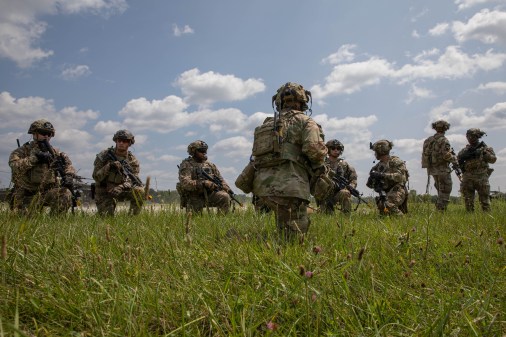Army advisers conclude 2nd iteration of Operation Combined Victory information environment exercise

The Army recently concluded the latest iteration of a validation exercise for its team of specialized foreign advisers that expanded upon elements of the information environment.
The Operation Combined Victory event — which took place in February and included the 1st, 2nd and 54th Security Force Assistance Brigades — was the second of its kind for the SFABs, which are unique units designed solely to advise and assist local, indigenous forces.
The exercise was conducted, in part, at Camp Atterbury and the Muscatatuck Urban Training Center in Indiana, which provide a raft of capabilities for modern battle and multi-domain warfare with the ability to remotely control infrastructure via cyber means — such as water systems — a radio station that forces can broadcast messages over FM for an information ops effect, and smart houses with Internet of Things devices that can be manipulated remotely, among others.
The forces relied on a contractor capability called Social Media Environment and Internet Replication product, or SMEIR, which provides a simulated social media and internet environment that includes virtual machines. The virtual machines allow participants and simulated users to send and receive emails as well as surf fake websites that include malicious links that can infect the entire network.
For example, during this second iteration of Operation Combined Victory, one member of the rotating force volunteered to be doxed as a means of demonstrating what can happen if social media isn’t locked down, according to a Security Force Assistance Command spokesperson.
Officials also expanded on the amount of information-related capabilities coordinated during the rotation to include enemy forces hacking into friendly radio stations.
The fictional adversary nation of Donovia interrupted broadcasts from the friendly nation of Pirtuni’s state-run news network.
Additionally, the mission partner environment built for the exercise was hacked into by the Donovians disrupting signals.
The objective behind Operation Combined Victory is to expose these adviser teams to the information environment in their respective roles.
In many cases, the SFABs are the only conventional U.S. Army forces deployed to a particular foreign country. If a conflict started in that nation or region, the advisers would already be there with their partners providing access, presence and influence.
“The whole basis behind the exercise is, if a conflict starts, we’re there to liaise and support follow-on forces, understanding the information environment as it evolves,” the spokesperson said. “We just want our advisers to be aware of the information environment and aware of their effects that they have on the information environment.”
The SFABs and Security Force Assistance Command also created what was dubbed an “ad hoc” G-39 for the exercise. A G-39 is the staff section within each echelon focused on information capabilities. It consisted of personnel from the SFABs and SFAC with psychological operations, civil affairs, public affairs and contractors that worked through SMEIR to inject information elements into the operating environment.
The spokesperson said there aren’t concrete plans as to how a potential G-39 as a permanent entity will progress in the future. Officials are still exploring options and looking at after-action reviews for lessons learned.
The spokesperson added that the team will look at the after-action reviews to see how they can expand Operation Combined Victory, which right now occurs twice a year. The exercises provide a unique training experience where the SFABs are the primary training audience and are focused on the information environment. Using capabilities available at Muscatatuck, officials can control how much or how little of a role the information environment plays, and tailor the events.
Long term, they’re looking at how they can get more repetitions for adviser teams from home station training through validation.




